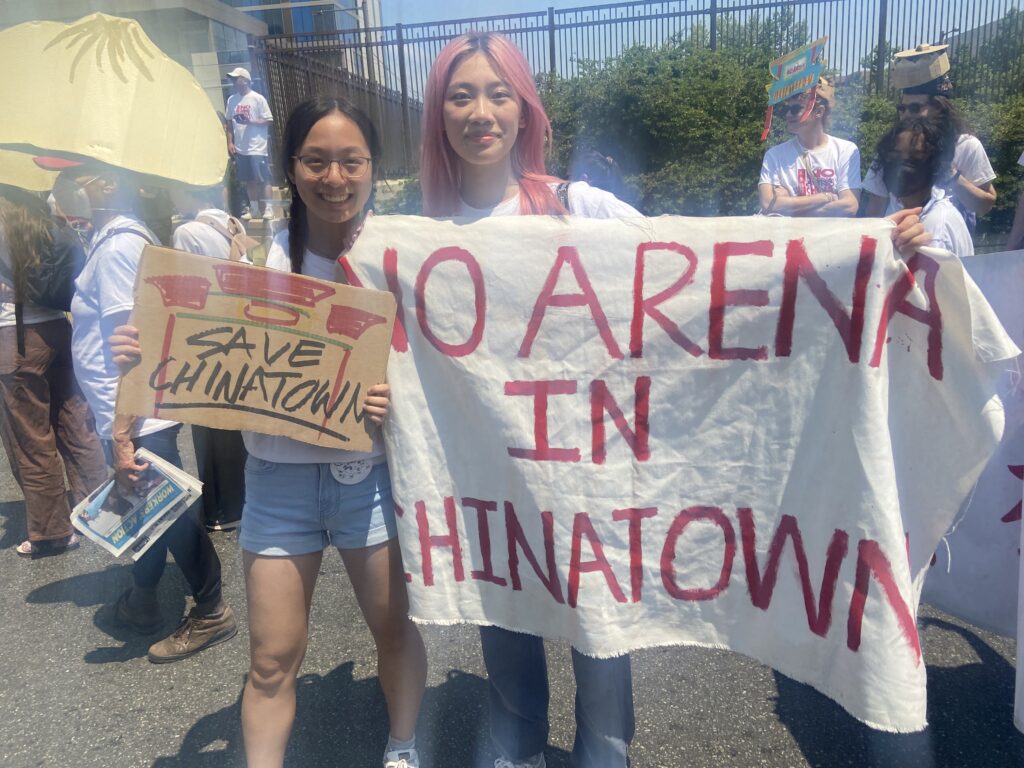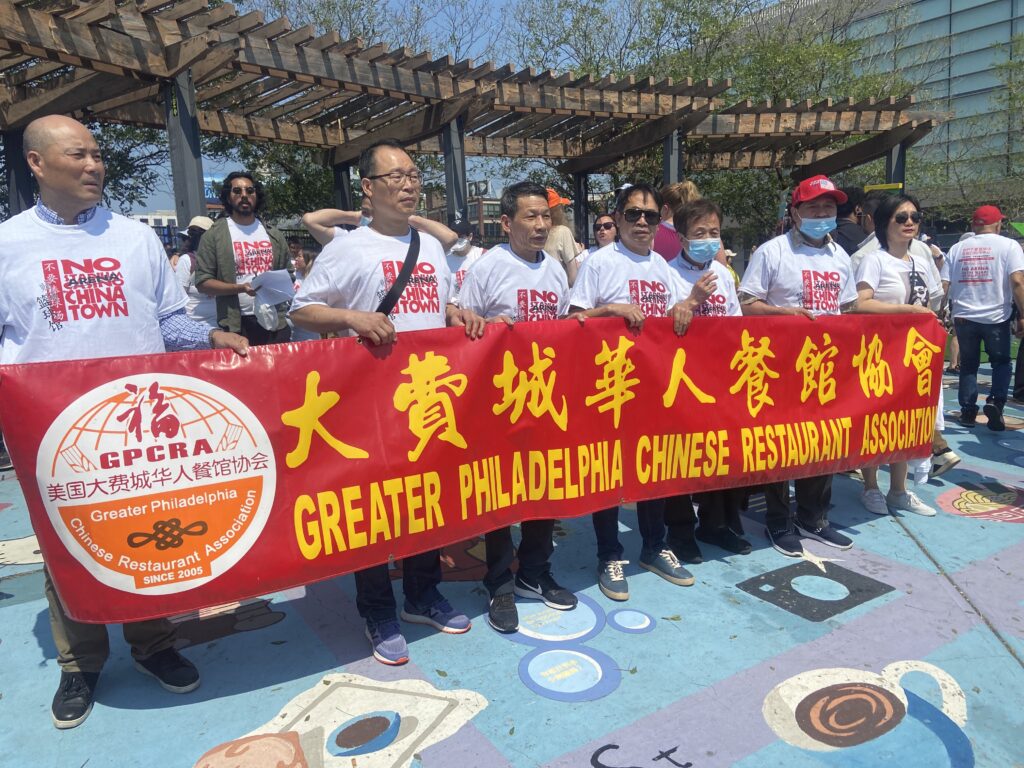Thousands March in Philadelphia Chinatown to Say ‘No Arena’

Over 3,000 people took to the streets of Philadelphia’s Chinatown this past Saturday. Wearing white shirts emblazoned with the words, “No Arena in Chinatown,” the crowd marched to City Hall, waving signs and chanting “protect Chinatown” in both English and Chinese.
They were there to demand the cancellation of a planned basketball stadium for the NBA’s Philadelphia 76ers, which opponents say poses an existential threat to Chinatown itself.
The march and subsequent rally were organized by the Save Chinatown Coalition and drew over 20 organizations from across the city. The multiracial group of attendees included students, restaurant owners, residents, priests, politicians, elders, and allies.
Each participant had a personal reason to fight for Chinatown. But their collective goal was simple, says organizer Mohan Seshadri: To demonstrate popular opposition to the proposed arena.
“We’re here to mobilize and show our elected officials especially… that the city is against this,” says Shashadri. “We’re here to show that this is bad not just for Chinatown, but it’s a bad deal for the entire city.”
A “celebration of our identity”
At 11am, marchers gathered at a Chinatown plaza and soon filled North 10th Street, leading to Chinatown’s iconic red gate. A traditional Chinese dance troupe practiced to the sounds of beating drums and cymbals. Flags written in Chinese fluttered in the air above colorful banners and signs, as coordinators distributed T-shirts and organizations lined up in marching order.
“I’ve never been to this big of a protest before,” said march participant Yoyo Godwin. “I’m just trying not to get overwhelmed with the amount of people.”
Organizers say the festive atmosphere was a central component of the march, which functioned as a celebration of Chinatown’s culture as well as a protest. Arts groups in attendance included traditional Chinese dance, wearable art and fashion, Korean drumming, and Mexican folk music. A large paper dragon and phoenix led the march; group sing-alongs were planned as part of the rally.
March organizer Wei Chen says that these cultural displays are critical to remind marchers and spectators alike of Chinatown’s importance — and highlight the “historic moment” they are participating in.
“We want people who participate in the march to feel this is not a funeral march,” said Chen. “This is a celebration to show our identity, to fight for our space and for future generations.”
High school students Queena Chen and Erica Zhong marched as part of the Students for the Preservation of Chinatown (SPOC), whose members have parents that participated in similar fights to protect the neighborhood from developers decades earlier.
“Chinatown is home to me, and I really want future generations to see how Chinatown is as a community, and how we can all come together to support a community,” said Zhong, who like Chen grew up in Chinatown.
For others, Chinatown has been a haven and home for decades. Sam Sam, often referred to as “Uncle Sam” by locals, came to the US as part of the influx of refugees from Vietnam in the 1980s. Sam grew up in Philadelphia’s Chinatown, and now runs the Little Saigon Cafe.
Many Chinatown residents, he observes, aren’t English proficient – which, he speculates, is why stadium developers were able to “mislead” them. But he also points out that residents are determined to protect their community.
“I love my town, that’s my home. You can’t kick me out. We will do everything to fight against it. We will win.”
A legacy of displacement
Saturday’s march was the highest attended Save Chinatown event by far. In the morning, the crowd spilled from the packed plaza, down Chinatown streets and onto nearby roadways. Spectators gathered on sidewalks, and some passersby even joined in.
March participant Helen Hui says the turnout reflects how “important” Chinatown is to many Philadelphians. Gesturing toward the row of shops, restaurants, and vendors that fill 10 North Street, with Chinatown gate in the distance, she adds this whole area would be destroyed if the arena was built.
“I was walking from the train station, and I thought, ‘oh, my. This is easily lost.’”
Corporate chains including H&M, Ulta Beauty, and Primark offered testament to her fears, lining the march route along the Fashion District area just past the Chinatown Gates, having displaced earlier, Chinese-owned establishments.
Marchers then wove underneath a section of the Pennsylvania Convention Center, construction of which displaced hundreds of Chinatown residents three decades earlier. Today a dim sum restaurant and a Chinese travel agency are all that remain of the earlier neighborhood.
Roseann Liu, a professor at Wesleyan College, was among the marchers and drew connections to the disappearance of Washington, D.C.’s Chinatown as well as others across the nation.
“There’s been a long history of Chinatown always being under incursion, and people doing big box developments trying to hem in the neighborhood,” says Liu.
“We want people to know that this is a community with its own history, and that we should be able to determine the rights of our community and to really stand for Asian American self-determination.”
As she spoke, protestors chanted, “We love Chinatown! People over profits!” and “Hands off Chinatown!” Drummers beat traditional Chinese drums to the crash of cymbals as a team of Indonesian motorcyclists brought up the rear.
The march ended with a rally in front of City Hall. Yu Min Wang is a member of the Pennsylvania United Chinese Coalition, which represents 36 organizations in Chinatown.
“What’s more important to the residents of Philadelphia is improving the safety in our city, it’s protecting the history and culture of our city so that we can have a peaceful life in harmony,” Wang said in Mandarin.
“The 76 developers have not done anything for us. Instead, for their own profit, they have made some promises to our residents. Do we have any reason to believe them?”
Sarun Chan, Executive Director of the Cambodian Association of Greater Philadelphia, described Chinatown as a “beacon of light” for immigrant communities across the nation, while organizations including Forza Juntos, Philly Thrive, and POWER Interfaith drew connections with fights against displacement in their own communities — past and present.
Empty promises
Antoinette Miles, who represents New Jersey’s Working Families Party, says that the Sixers have already failed Camden, NJ — a primarily Black and Hispanic city across the Delaware River from Philadelphia.
In 2014, the Sixers received an $82 million tax break in order to build a headquarters and training facility in Camden. Developers claimed the facility would bring jobs and boost the local economy. Yet ten years later, the team has only hired 11 residents out of 275 total employees.
“Camden is a proud, hardworking, historical, vibrant community with a majority of black and Hispanic families. And we have already seen the kind of neighbor that the Sixers would be,” says Miles.
“I am here to tell you that the Sixers have already failed the city of Camden. How can they be trusted to keep their promises to Chinatown?”
Rally participants, meanwhile, expressed their desire for Chinatown’s survival and its continued growth and strength.
96-year-old Chang Kai Jong says his decision to attend, despite his age, was simple: He “had to come out.” Jong came to Chinatown at a time when the neighborhood was far smaller — just a handful of people and stores, he recalls. Over the decades, he’s seen Chinatown grow despite repeated attempts by developers to smother the neighborhood.
“We will stay here,” he says. “We must stay here and continue to develop.”


















